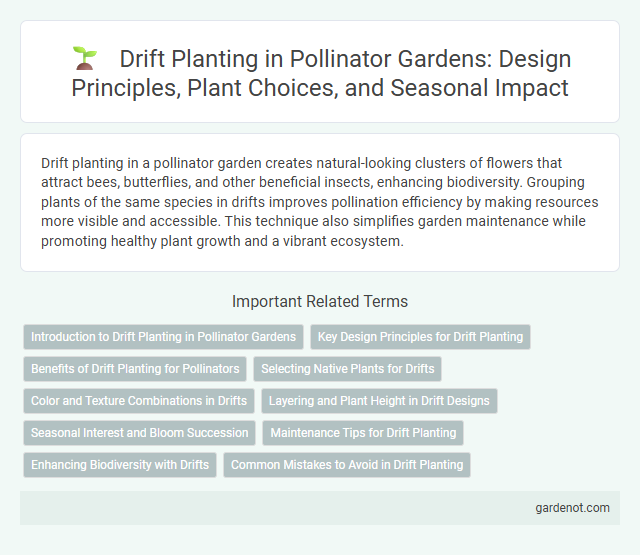Drift planting in a pollinator garden creates natural-looking clusters of flowers that attract bees, butterflies, and other beneficial insects, enhancing biodiversity. Grouping plants of the same species in drifts improves pollination efficiency by making resources more visible and accessible. This technique also simplifies garden maintenance while promoting healthy plant growth and a vibrant ecosystem.
Introduction to Drift Planting in Pollinator Gardens
Drift planting in pollinator gardens enhances habitat connectivity by grouping clusters of native nectar-rich flowers, creating continuous resources for bees, butterflies, and hummingbirds. This technique mimics natural floral patterns, promoting pollinator movement and visitation rates, which supports biodiversity and plant reproduction. Using drift planting increases garden efficiency and visual appeal while sustaining essential pollinator populations.
Key Design Principles for Drift Planting
Drift planting involves grouping plants of the same species in large, flowing masses to mimic natural ecosystems, enhancing visual impact and supporting pollinator habitats effectively. Key design principles for drift planting include selecting native, drought-tolerant species that bloom in succession, ensuring continuous nectar sources for bees, butterflies, and other pollinators. Proper spacing and layering of plants optimize airflow and sunlight penetration, promoting plant health and maximizing pollinator attraction.
Benefits of Drift Planting for Pollinators
Drift planting enhances pollinator habitats by creating large, continuous clusters of native flowering plants that attract and support a diverse array of bees, butterflies, and other pollinators. This planting technique improves foraging efficiency by providing abundant nectar and pollen sources, promoting longer visits and higher pollination rates. Concentrated plant groups also improve habitat connectivity, facilitating pollinator movement and contributing to greater biodiversity in garden ecosystems.
Selecting Native Plants for Drifts
Selecting native plants for drift planting enhances pollinator gardens by creating large, cohesive patches that attract bees, butterflies, and hummingbirds. Native species like Echinacea, Monarda, and Asclepias thrive in local climates and provide essential nectar and pollen resources throughout the growing season. Grouping these plants in drifts supports pollinator biodiversity and promotes easier foraging and habitat connectivity.
Color and Texture Combinations in Drifts
Drift planting in pollinator gardens enhances biodiversity by grouping plants with vibrant color and diverse textures to attract various pollinators. Combining soft, feathery grasses with bold, brightly colored blooms like coneflowers and black-eyed Susans creates visual contrast and continuous seasonal interest. Strategic color and texture combinations improve habitat quality and support butterfly, bee, and hummingbird populations throughout the growing season.
Layering and Plant Height in Drift Designs
Drift planting in pollinator gardens emphasizes strategic layering and plant height variation to maximize habitat diversity and nectar availability. Taller plants such as milkweed and coneflowers form the upper canopy, attracting butterflies and bees, while mid-height perennials like goldenrod provide abundant pollen sources. Ground-level blooms including creeping thyme and sedum foster shelter and foraging opportunities for ground-nesting pollinators, creating a multi-dimensional, thriving ecosystem.
Seasonal Interest and Bloom Succession
Drift planting in pollinator gardens enhances seasonal interest by clustering plants with staggered bloom times, ensuring continuous floral resources for pollinators from early spring through late fall. Selecting native perennials like Echinacea, Monarda, and Solidago creates a persistent sequence of nectar and pollen availability, supporting diverse pollinator species throughout their active periods. This strategic bloom succession maximizes habitat value and promotes ecosystem resilience within the garden.
Maintenance Tips for Drift Planting
Drift planting in pollinator gardens requires strategic maintenance to ensure sustainable growth and bloom continuity. Regular pruning and deadheading promote healthy plant development and prevent overcrowding, enhancing nectar availability for pollinators. Soil moisture monitoring and weed control are essential to maintain optimal conditions that support diverse pollinator species year-round.
Enhancing Biodiversity with Drifts
Drift planting in pollinator gardens creates large, continuous patches of native flowering plants that support diverse insect populations, including bees, butterflies, and hoverflies. This method enhances biodiversity by providing consistent foraging resources and habitat connectivity, which encourages pollinator movement and nesting. Establishing these dense clusters of species-rich plantings strengthens ecosystem resilience and promotes long-term sustainability of pollinator communities.
Common Mistakes to Avoid in Drift Planting
Drift planting often suffers from common mistakes such as overcrowding, which limits airflow and increases disease risk in pollinator gardens. Improper species selection ignoring bloom time diversity can reduce continuous nectar sources for pollinators. Neglecting soil preparation and site conditions leads to poor plant establishment and suboptimal habitat quality.
Drift planting Infographic

 gardenot.com
gardenot.com